The road to nirvana |
|
My journey into Photography, Horology, and Audiophilia |
My "baby Dfour"
First post: December 23, 2013
Introduction
I wasn't even aware that such thing exist until my friends pointed me to the then rumoured retro-styled camera from Nikon. Not having owned any of its supposed "F" ancestors, I am not particularly interested in the looks. What piqued my interest was the sensor which is supposedly derived from the Nikon D4, a camera I like to have but not willing to spend that much money on.
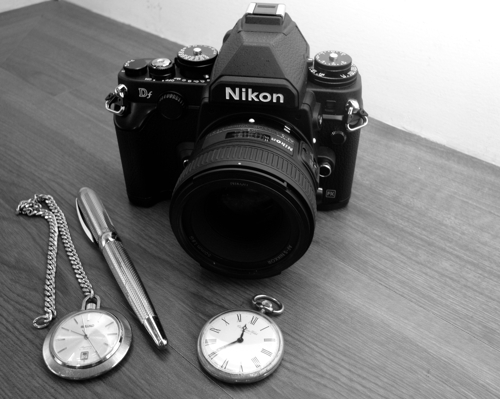
Specifications
I am not going to repeat the specifications that Nikon provides for the public.
Fear, uncertainty, and doubt
The Df though equipped with a sensor from the D4 use an auto-focus module that is lower grade than what is in my D800, the MultiCAM 4800.
The MultiCAM 4800 offers TTL phase detection, fine-tuning, and 39 focus points (including 9 cross-type sensors; the center 33 points are available at apertures slower than f/5.6 and faster than f/8, while the center 7 focus points are available at f/8) which in short, is the FX version of the MultiCAM-4800DX in my previous D7000.
My D7000 served me well, and the reason for going with the D800 was the better AF module and FX. The reason for going with the Df is that D4 sensor in it.
I felt that it is a step forward (D4 sensor) and a step back (MultiCAM 4800 module), but in the end I'll find out how these two will "inspire" me.
General features that I like
- Sensor technology from the D4.
- Lighter, smaller body than my D800.
- Shooting menu banks like my D800: With four storage banks, A, B, C, and D, I can now store different shooting menu settings and have the capability to recall any one of them. On my D800, they are set for venue, Standard (A), The Arena San Juan (B), Ynares Stadium (C), and MOA Arena (D). I plan to do the same for the Df.
- Custom settings banks: Similar to the Shooting menu banks, I can store four different custom settings and have them recalled. Again, on my D800 they're set for Portraits (A), and Sports (B). Banks C and D are not yet used.
- Ability to use pre-AI lenses. Not that I have an inventory of those, but in case I acquire one, this capability will be useful.
Size compared with my film cameras
While it is moot to make such comparison, I took photos of the Df beside my film cameras, the Nikon N65 and Zeiss Ikon Contaflex Synchro-Compur.
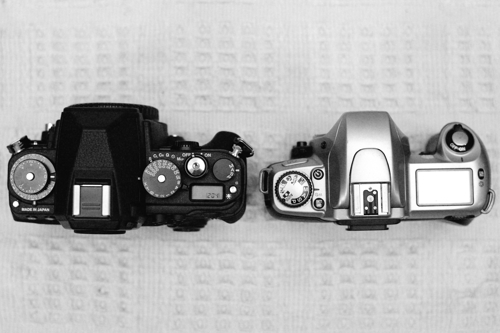
Nikon Df compared with Nikon N65
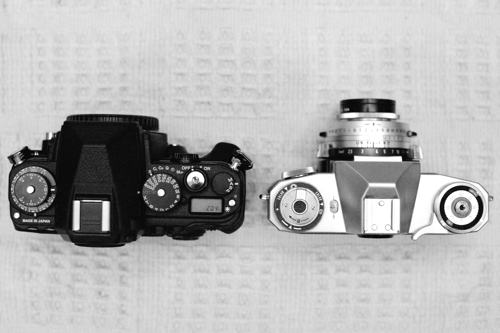
Nikon Df compared with Zeiss Ikon Contaflex Synchro-Compur
Operation
Exposure mode dial
This locking dial selects the Programmed Auto
(P), Aperture-priority (A), Shutter-priority (S) and Manual (M)
mode. To turn it, it has to be lifted first.
The way it is located on the body, a locking
mechanism is needed otherwise it is easy to accidentally turn it
with the fore finger. I have a mixed feeling on how the locking is
implemented. The D800 doesn’t even have a dial, pressing the MODE
button and turning the main-command dial is the equivalent.
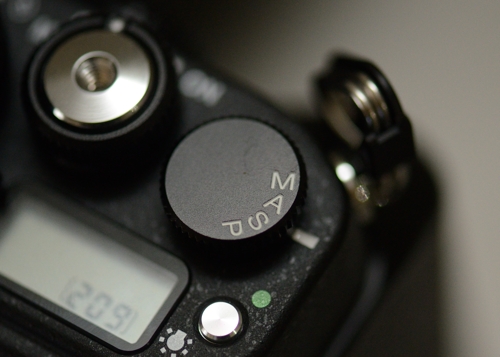
Shutter-speed dial
This locking dial sets the shutter speed in the
following increments- 4, 2, 1, 2, 4,
8, 15, 30, 60, 125, 250, 500, 1000, 2000, and 4000. The positions B
(Bulb), T (time) and X (flash sync) are also available. To use the
sub-command dial to change the shutter to more precise steps, it
must be at the
1/3 STEP position. A lock release button on the center of the
dial needs to be pressed to turn the dial.
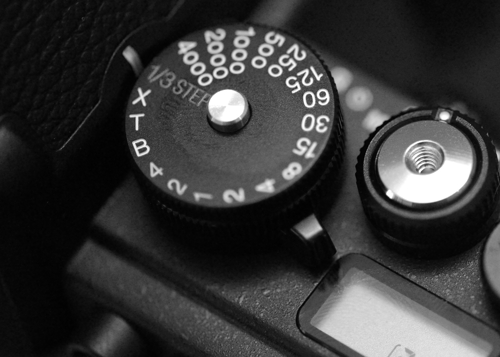
Release mode dial
This dial selects the Single release (S),
Continuous Low release (CL), Continuous High release (CH), Quiet
release (Q), Timer, or Mirror-up (Mup) setting. Operating the dial
is easy via a small lever.
ISO dial
This locking dial sets the maximum ISO
sensitivity, and unlike the D800, can not be set from the menu. To
emulate the ISO dial operation on the D800, I press the INFO button,
then press and hold the ISO button while turning the main-command
dial to select the ISO sensitivity value. Much easier on the Df!
The lock release button adjacent to the dial
must be pressed to turn the dial.
When you set Auto ISO sensitivity control to ON
and the ISO dial is set to a value greater than the Auto ISO Maximum
sensitivity, i.e., ISO sensitivity > Maximum sensitivity, a warning
that reads “The maximum value for auto ISO sensitivity control will
be set to the value selected
for ISO sensitivity.”
In actual operation, it differs from the D800
and may be confusing. On the D800, if ISO sensitivity is set to 6400
and Auto ISO Maximum sensitivity is set to 3200, when the Auto ISO
sensitivity control is set to ON, only ISO 3200 will take effect
regardless of P, A, S or M mode.
On the Df
it becomes interesting when Auto ISO sensitivity control is ON. The
ISO dial setting (ISO sensitivity on the menu) overrides the Auto
ISO Maximum sensitivity value, thereby “extending” it. The lowest
ISO is 100 in auto ISO mode.
|
|
D800 |
Df |
D800 |
Df |
|
ISO sensitivity |
6400 |
6400 |
1600 |
1600 |
|
Auto ISO Maximum sensitivity |
3200 |
3200 |
3200 |
3200 |
|
Effective maximum sensitivity (Auto ISO
sensitivity control ON) |
3200 |
6400 |
3200 |
3200 |
|
Effective maximum sensitivity (Auto ISO
sensitivity control OFF) |
6400 |
6400 |
1600 |
1600 |
The exposure compensation dial
This locking dial allows setting of the
exposure compensation. The lock release button on the center of the
dial must be pressed to turn the dial. Turn clockwise for positive
compensation, and counter-clockwise for negative compensation.
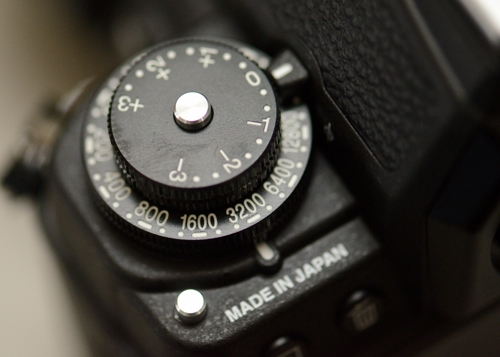
AF button
When the AF button is pressed, the LCD turns on
unlike the D800. I suppose this is to let you see the AF state as
you operate the sub-command dial. Unlike the D800 that can show the
“3D” from the focus points, the Df
cannot so it turns on the LCD so you know what state the AF is on.
Battery indicator
My Df
won’t power on even if the battery indicator shows
⅓ bar left. Not a
very good indication of remaining power.
There is no battery meter like what is
available on the D800. Not a deal breaker, but it would be nice to
have.
Eye-Fi support
The Df,
like the D800, J1 and even the Coolpix S3300) supports Eye-Fi cards. However, there are times that
it hangs. When a shot is made and the activity lamp is on, never
press the Play button, as it will cause to hang. Similiarly, when
the Df has just been
turned on and the activity lamp is on, do not press the Play button.
In general, when the activity lamp is on, wait until it extinguishes
before interacting with the Df.
I also found out that both the D800 and Df
cannot format my Eye-Fi card. I format it using my J1.
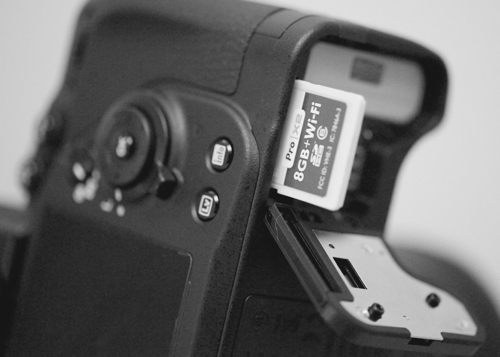
Initial impressions
At the store where I picked up the unit, I fired three test shots at the store counter where the lighting is dim. I set the ISO dial to 6400 and used P-mode as I haven't figured out yet how to adjust the Exposure mode dial.
This is the result-
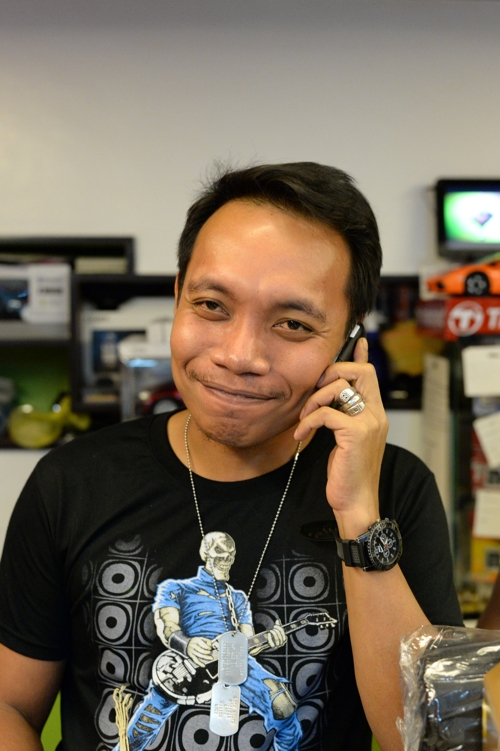
50mm f/1.8 @ f/4, 1/60, ISO 6400, hand-held
At ISO 6400, I am excited by the new level of performance it offers.
At the office, I found a good subject at the pantry so I turned all the lights off. The only source of light is from the window heavily diffused by the blinds. The Df did not have difficulty in acquiring and locking focus using the left-most AF point.
Here's how it was-

50mm f/1.8 @ f/1.8, ISO 12800, hand-held
I am pretty pleased with the high-ISO performance that will augment my D800. I now have the coveted D4 sensor!
The following photo was taken at a friend's restaurant called Recovery Food, same owners as Mamou which is famous for steaks. What caught my fancy were the beef bones we call "bulalo" which were stripped off of the meat.
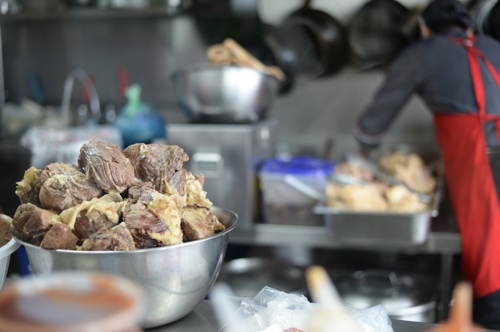
50mm f/1.8 @ f/2.2, 1/20, ISO 100, hand-held
I'd be lying to myself if I will not admit the Df do have trouble with auto-focus on a particular scene that my D800 locked in easily. I was taking photos of my new Harman Kardon SOHO in preparation for a review when I noticed the behaviour.
I'm in a section of the house with about 4m x 4m space lit by a ceiling lamp with three small 10w flourescent bulbs, and the Df will not focus lock on the subject. From the The focus point is at the first O and from the shadow the source of light is evident.
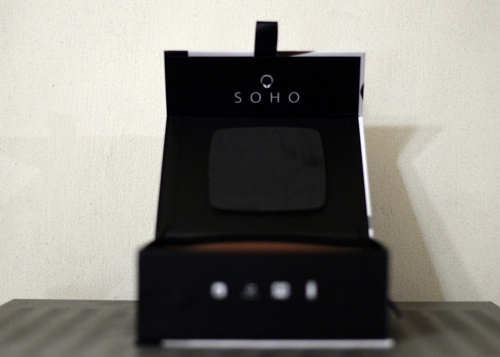
I was able to take the shot by manual focus override, but I didn't nail it. The following shot is the same subject and scene but taken with the D800 and the same AF-S 50mm f/1.8 G.

It is immediately noticeable how the D800 was able to lock in and is very sharp at the focus point. I do not use AF-assist illuminator on my D800.
I found another scene that both the Df and the D800 won't lock focus.

D800 + 50mm f/1.8 at f/1.8, ISO 6400, 1/160.
If I focus at the center, the D800 and Df will not lock focus, and at times will hunt. I was able to take the shot by shifting focus as indicated.
I thought of taking advantage of the 7-days replacement policy of the merchant. But after further tests when the D800, and even the J1 won't lock focus on the subject, I concluded that there is nothing wrong with my Df and will not warrant replacement.
Gallery
Images may take sometime to load, depending on the speed of your Internet connection.
No flash player!
It looks like you don't have flash player installed. Click here to go to Macromedia download page.
Powered by Flash Gallery